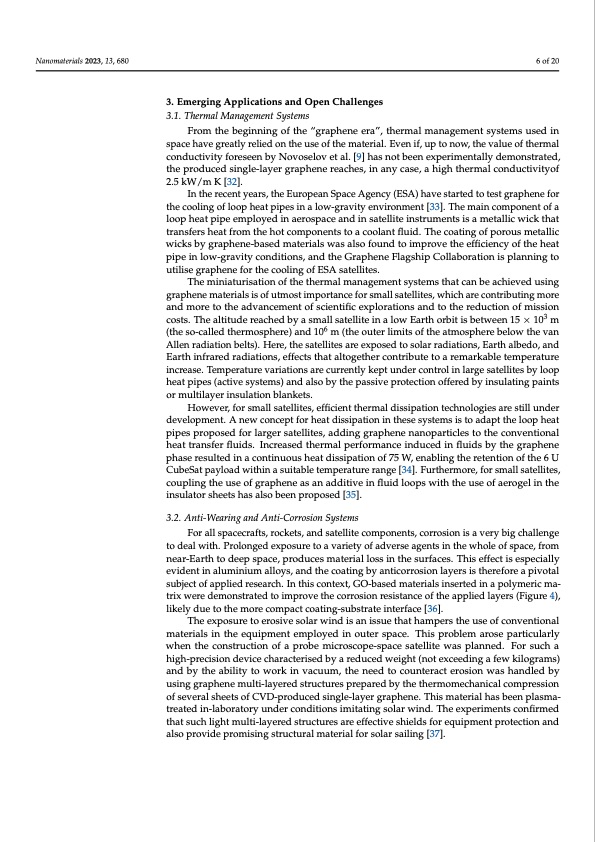PDF Publication Title:
Text from PDF Page: 006
Nanomaterials 2023, 13, 680 6 of 20 3. Emerging Applications and Open Challenges 3.1. Thermal Management Systems From the beginning of the “graphene era”, thermal management systems used in space have greatly relied on the use of the material. Even if, up to now, the value of thermal conductivity foreseen by Novoselov et al. [9] has not been experimentally demonstrated, the produced single-layer graphene reaches, in any case, a high thermal conductivityof 2.5 kW/m K [32]. In the recent years, the European Space Agency (ESA) have started to test graphene for the cooling of loop heat pipes in a low-gravity environment [33]. The main component of a loop heat pipe employed in aerospace and in satellite instruments is a metallic wick that transfers heat from the hot components to a coolant fluid. The coating of porous metallic wicks by graphene-based materials was also found to improve the efficiency of the heat pipe in low-gravity conditions, and the Graphene Flagship Collaboration is planning to utilise graphene for the cooling of ESA satellites. The miniaturisation of the thermal management systems that can be achieved using graphene materials is of utmost importance for small satellites, which are contributing more and more to the advancement of scientific explorations and to the reduction of mission costs. The altitude reached by a small satellite in a low Earth orbit is between 15 × 103 m (the so-called thermosphere) and 106 m (the outer limits of the atmosphere below the van Allen radiation belts). Here, the satellites are exposed to solar radiations, Earth albedo, and Earth infrared radiations, effects that altogether contribute to a remarkable temperature increase. Temperature variations are currently kept under control in large satellites by loop heat pipes (active systems) and also by the passive protection offered by insulating paints or multilayer insulation blankets. However, for small satellites, efficient thermal dissipation technologies are still under development. A new concept for heat dissipation in these systems is to adapt the loop heat pipes proposed for larger satellites, adding graphene nanoparticles to the conventional heat transfer fluids. Increased thermal performance induced in fluids by the graphene phase resulted in a continuous heat dissipation of 75 W, enabling the retention of the 6 U CubeSat payload within a suitable temperature range [34]. Furthermore, for small satellites, coupling the use of graphene as an additive in fluid loops with the use of aerogel in the insulator sheets has also been proposed [35]. 3.2. Anti-Wearing and Anti-Corrosion Systems For all spacecrafts, rockets, and satellite components, corrosion is a very big challenge to deal with. Prolonged exposure to a variety of adverse agents in the whole of space, from near-Earth to deep space, produces material loss in the surfaces. This effect is especially evident in aluminium alloys, and the coating by anticorrosion layers is therefore a pivotal subject of applied research. In this context, GO-based materials inserted in a polymeric ma- trix were demonstrated to improve the corrosion resistance of the applied layers (Figure 4), likely due to the more compact coating-substrate interface [36]. The exposure to erosive solar wind is an issue that hampers the use of conventional materials in the equipment employed in outer space. This problem arose particularly when the construction of a probe microscope-space satellite was planned. For such a high-precision device characterised by a reduced weight (not exceeding a few kilograms) and by the ability to work in vacuum, the need to counteract erosion was handled by using graphene multi-layered structures prepared by the thermomechanical compression of several sheets of CVD-produced single-layer graphene. This material has been plasma- treated in-laboratory under conditions imitating solar wind. The experiments confirmed that such light multi-layered structures are effective shields for equipment protection and also provide promising structural material for solar sailing [37].PDF Image | Role of Graphene in Space Technology

PDF Search Title:
Role of Graphene in Space TechnologyOriginal File Name Searched:
nanomaterials-13-00680-v2.pdfDIY PDF Search: Google It | Yahoo | Bing
Salgenx Redox Flow Battery Technology: Power up your energy storage game with Salgenx Salt Water Battery. With its advanced technology, the flow battery provides reliable, scalable, and sustainable energy storage for utility-scale projects. Upgrade to a Salgenx flow battery today and take control of your energy future.
CONTACT TEL: 608-238-6001 Email: greg@infinityturbine.com (Standard Web Page)